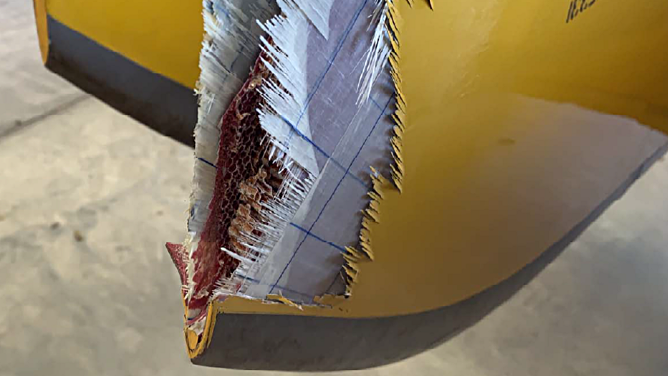An Australian Transport Safety Bureau (ATSB) investigation into an accident where the main rotor blades of an AW139 emergency services helicopter struck trees while winching a rescue crew officer during a medical retrieval task on June 20, 2020, is continuing.

Of the helicopter’s five main rotor blades, one blade sustained significant damage to its tip cap. The same blade also sustained a small skin puncture about one meter (three feet) from the blade tip, while two other blades showed evidence of damage to the abrasion strip on the outer most edge of the tip cap.
The helicopter, operated by Queensland Government Air and using the callsign “Rescue 500,” was retrieving a horse rider who was injured in a fall at a property west of Caboolture. The flight was conducted at night with the aircrew using the helicopter’s night vision imaging system, including night vision goggles. The rotor strike occurred when the rescue crew officer (RCO) was being winched on board the helicopter from a confined area, after the patient, in a stretcher, and the flight paramedic had been winched back together into the helicopter.
“An ATSB preliminary report from the ongoing investigation notes that after the rotor blades struck the trees, the pilot immediately applied collective input to climb and maneuvered the helicopter to the left away from the tree line,” said ATSB director of transport safety, Dr. Stuart Godley.
As the helicopter moved away from the confined area the RCO was partially dragged through surrounding trees, before being recovered back into the helicopter, the report notes.
“The pilot reported that feedback through the flight controls remained normal and the helicopter’s crew alerting system remained clear, with no abnormal vibrations felt by the pilot or detected by the helicopter systems,” Godley said.
The pilot elected to return to the helicopter’s base at Archerfield, where a running landing was completed and the patient was transferred to a road ambulance.
A subsequent engineering examination of the helicopter identified the damage to the three main rotor blades. After inspection by ATSB transport safety investigators, the damaged blades were then shipped to the helicopter’s manufacturer, Leonardo, in Italy for detailed inspection and repair.
“ATSB preliminary reports detail factual information established in the investigation’s early evidence collection phase, and contain no analysis or findings, which will be detailed in the investigation’s final report,” Godley noted.
As the investigation continues, the ATSB will conduct a detailed aerial survey of the incident site.
“The ongoing investigation will also include detailed examination and analysis of the weather conditions and data from the helicopter’s multi-purpose flight recorder, a review of the operator’s procedures and risk controls and aircrew training records, and analysis of the AW139 helicopter’s autohover and anti-vibration systems.”
The ATSB noted that Queensland Government Air has reported taking a number of proactive safety actions in response to the incident.
These include issuing several standards directives to its aircrew including a requirement for the pilot-in-command to land as soon as possible when either “suspecting or observing” helicopter damage, and introducing terrain/obstacle clearance limits depending on the nature of the environment and task.
The operator has also released aircrew memorandums providing additional guidance regarding the potential for the AW139 active vibration control system to mask significant damage to the main rotor blade system, clarification regarding the limitations when using the autohover system, and aircrew-related fatigue management requirements.
Read the full preliminary report here: https://www.atsb.gov.au/publications/investigation_reports/2020/aair/ao-2020-031/









